
Best For
- Excellent cooling with cooling cover and graphite-infused memory foam
- Fast response time
- Excellent edge support, only 3.25″ of sinkage directly at the edge
Considerations
- Higher motion transfer than average (10.90 m/s²)
- $1,349 for a queen—12% less than the average price for a memory foam hybrid
Our Verdict
The Zoma Boost mattress is a high-profile 15″ memory foam hybrid with graphite-infused memory foam and a pocketed support coil base. It has great performance across the board, with excellent cooling, fast response time, and outstanding pressure relief.
It has moderate sinkage and moderately high bounce giving the mattress a balanced feel. It comes in a single firmness option that is a 6 out of 10, making it good for a wide array of sleepers.
The Zoma Boost has an overall score of 8.88, which placed it in the top 29% percentile compared to all mattresses tested to date. It has a price of $1,349, which is 12% less than the average memory foam hybrid price of $1,534 (for a savings of $185 on a queen mattress).
The only real downside to this mattress is higher levels of motion transfer. If you’re a sensitive sleeper, this could be a problem, but may not affect all sleepers in the same way.
Type: Memory Foam Hybrid
Firmness: Medium Firm (6)
Best For: All Sleeping Positions, All Body Weights
In This Review
Performance Tests | Firmness | Support & Sleeping Positions | Design | Materials | Comparisons | FAQs
Performance Tests
At NapLab, we put each mattress to the test.
We test 10 different factors that impact the performance, comfort, and value of the mattress. We then take the results of that test and compare to every mattress we’ve tested to date.
Check out the full performance table below to see how this mattress ranks:
| Factor | Zoma Boost | Average |
|---|---|---|
| Overall Score | 8.88 | 8.55 |
| Price (Queen) | $1,349 | $1,534 (Memory Foam Hybrid only) |
| Cooling – Score | 9.0 | 8.7 |
| Sinkage – Depth | 2.10″ | 2.14″ |
| Sinkage – Feel | Moderate | Moderate |
| Motion Transfer – Score | 7.3 | 8.2 |
| Motion Transfer – Acceleration | 10.90 m/s² | 8.78 m/s² |
| Response Time – Score | 8.8 | 8.9 |
| Response Time – Mostly Recovered | 0.3 sec. | 0.4 sec. |
| Response Time – Fully Recovered | 1.2 sec. | 0.9 sec. |
| Bounce – Height | 8.45″ | 9.53″ |
| Bounce – Feel | Moderate | Moderate |
| Edge Support – Score | 9.4 | 8.6 |
| Edge Support – Sitting | 3.25″ | 4.04″ |
| Edge Support – Lying | Excellent | Good |
| Sex – Score | 8.5 | 8.4 |
| Pressure Relief – Score | 10 | 8.7 |
| Comfort Layer Thickness | 5.0″ | 4.1″ |
| Mattress Thickness | 15″ | 12.0″ |
| Off-Gassing – Score | 8.3 | 8.1 |
| Off-Gassing – Smell | Strong | Strong |
| Off-Gassing – Days | 6 days | 7 days |
| Company – Score | 9.0 | 8.8 |
| Trial | 100 nights | 177 nights |
| Warranty | 10 years | 25% have lifetime warranties, average of other 75% of mattresses is 13 years |
How is the Boost Different?
The Zoma Boost is $1,349 for a queen, which is 12% less than the average memory foam hybrid.
The Boost has a performance that is a good deal better than average as well. Where the average mattress has an overall performance rating of 8.57, the Zoma Boost has a score of 8.88. The price and performance together make for a mattress that has pretty good value.
Advantages
The mattress has a 15″ profile which is thicker than most mattresses. The average mattress thickness across all mattresses tested to date is 12.0″. Compared to the average, the Zoma Boost provides over 3″ more thickness, much of that being allocated to the high-profile comfort layer.
Pressure relief is exceptional and significantly better than the average mattress. Cooling is a bit better as well, but not by very much. The Boost does have notably better performance in Edge Support, though.
Neutral Factors
The Zoma Boost has a fairly average level of sinkage, as compared to the other 250 mattresses we’ve tested so far. This is a moderate level.
Bounce is about average as well, if not just a bit lower than average. Comparatively, bounce is about 13% lower.
Disadvantages
The biggest area that the Zoma Boost does worse than other mattresses is motion transfer. Here, the Boost showed significantly more and longer motion.
It company policies include a slightly shorter trial and warranty period.
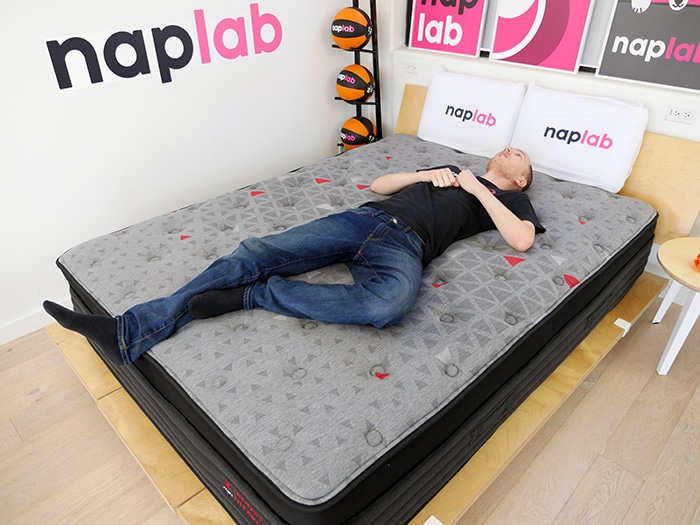
If you’re looking for a Zoma on a budget, they also offer the Zoma Hybrid and Zoma Start (all foam), which are both less expensive options than the Boost.
Cooling Test
The Zoma Boost has excellent cooling performance. During our tests, I felt no significant heat retention around my body.
The mattress uses a cooling cover (most likely phase change materials, but it doesn’t say for certain), graphite-infused comfort foam, and a hybrid design to help maintain a comfortable temperature.
Baseline Temp.
67.6° F
Max Temp.
87.2° F
Ending Temp.
76.7° F
This combination of materials and design functions well to improve overall airflow and breathability on the mattress. In our objective cooling tests, we measured a maximum surface level temperature of 87.2° F.
Max Temp.

Ending Temp

- Baseline Temperature – the temperature of the mattress before anyone lies on it
- Maximum Temperature (0 minute) – the temperature of the mattress after lying on it for 15 minutes
- Ending Temperature (5 minute) – the temperature of the mattress after being lied upon and having no one on it for 5 minutes
From minutes 0 to 1 the Boost was able to reduce the temperature by 5.9°, with a 10.5° reduction from minutes 0 to 5. When we look at the complete picture of subjective experience, mattress materials, and objective data, I am confident that the mattress will meet the cooling needs of most sleepers.
Heat Dissipation Over Time
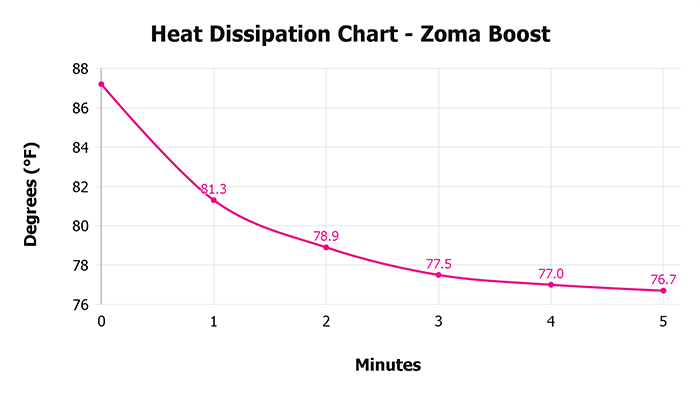
Sinkage Test
The Zoma Boost has a moderate level of pressure point sinkage. In our tests, we measured a sinkage depth of 2.10”. This is 0.02” less sinkage than the average of 2.14” (based on all of our tests to date).
Sinkage Depth
2.10″
Sinkage Feel
Moderate
Body Contour
Balanced
The level of sinkage is documented in the image below.

The mattress definitely has a noted contouring hug. However, it is quite balanced around the body. It’s neither too sharp (like memory foam can be) nor too mushy (like latex or more traditional mattresses can be).
The middling feel creates an ideal level of comfort, support, and pressure relief. The Zoma Boost uses a 2.0” memory foam layer, however, it’s notably below a 1.5” quilted cover.
The quilted cover restrains that memory foam layer from overly contouring to your body. This design is what creates a balanced and comfortable feel.
Motion Transfer Test
The Zoma Boost has a moderate level of motion transfer. In our tests, we measured 10.90 m/s² of acceleration range. This is 2.12 m/s² more motion than the average of 8.78 m/s². This level of motion is a bit higher than I expected, but nothing too outlandish.
Accel. Range
10.90 m/s²
Motion Duration
0.79 seconds
The level of motion transfer is documented in the video below.
The medium-firm feel and densely packed euro-top creates an environment for heightened pushback in the comfort layer. These design factors, in combination with the support coil base, create a higher motion.
When we look at our motion transfer chart, which visualizes our accelerometer data, we can see the highest motion through 0.14 seconds. Motion drops off notably, but still remains moderately high until 0.79 seconds.
By 0.79 seconds, motion returns to near-zero levels. Mattresses with the lowest motion duration are able to disperse all energy by 0.3 seconds.
Motion Transfer Over Time
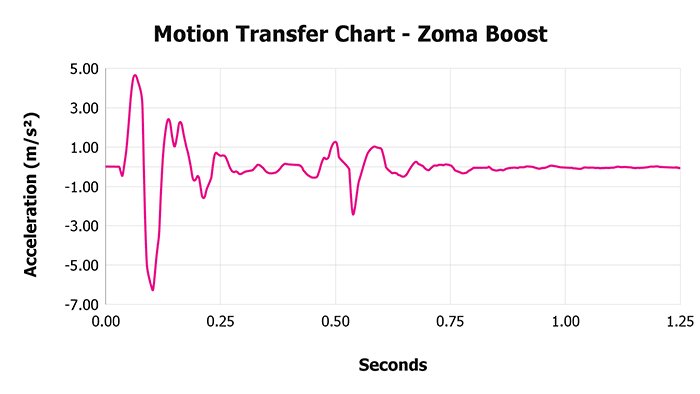
Like the motion peaks, the motion duration is reasonably low, but not incredibly so. I would expect most sleepers won’t be bothered by this level of motion. However, hyper-sensitive sleepers may find it too high.
Response Test
The Zoma Boost has a mixed response time. In our tests, we measured a mostly recovered response time of 0.3 seconds. This places it within the “extremely fast” category and it’s faster than the average of 0.45 seconds (based on all of our tests to date).
Mostly Recovered
0.3 sec.
Complete Recovery
1.2 sec.
The level of responsiveness is documented in the video below.
However, the fully recovered response time came in at 1.2 seconds. This is notably slower than the average of 0.89 seconds (for full recovery).
While the bulk of the mattress rebounds back to shape instantly, the memory foam layer does take an extra moment to fully recover. As with motion transfer, it’s not overly dramatic and I don’t think most sleepers will be bothered by the responsiveness.
Bounce Test
The Zoma Boost has a moderate level of bounce. In our tests, we measured a total bounce height of 8.45”. This is 1.08” less bounce than the average of 9.53”.
Max. Depth
4.82″
Max. Rebound
3.63″
Total Bounce
8.45″
In the same way that the memory foam layer helps to reduce motion and slow the response time, that same memory foam layer is also reducing bounce.
Max. Sinkage Depth

Max Bounce Height

While bounce is a preferential factor, in general, moderate to high levels are better as they improve sex, response, and ease of movement.
The level of bounce is also documented in the video below.
Ideally, I like to see 8-12” of total bounce height. At 8.45”, the Zoma Boost is on the lower end of the sweet spot, but still within it. At this level of bounce it’s enough to provide the benefits, without being so high as to create new issues.
Edge Support Test
The Zoma Boost has excellent sitting and lying edge support. In our sitting edge support test, we measured 3.25” of sitting edge sinkage. This is 0.79” less sinkage than the average of 4.04”.
Max. Sinkage
3.25″
Lying Support
Excellent
Reinforced Edge
Yes
When it comes to sitting compression I like to see 4.0” or less. At 3.25” the Zoma Boost easily exceeds that mark. Even when sitting directly on the edge of the mattress I feel incredibly well-supported.
The level of edge support while seated is documented in the images below.
Sitting, 140 lbs.

Sitting, 200 lbs.

Edge support while lying is equally as impressive. During our tests, I felt well-supported in all sleeping positions even when lying directly on the edge of the mattress.
The level of edge support while lying is documented in the images below.
Lying on Edge, 140 lbs.

Lying on Edge, 200 lbs.

The robust 15” total mattress thickness, 10” support system, and reinforced edge support coils create the right recipe for fantastic edge support.
Sex Test
Our sex rating formula looks at 5 different factors weighted based on their importance. All factors are not equal in terms of significance, but each plays an important role.
We use the scores from all factors, plugged into the formula above, to derive a sex score for each mattress.
| Sex Factor | Factor Weight | Score | Rating |
|---|---|---|---|
| Bounce | 65% | 7.8 | Moderate |
| Edge Support | 20% | 9.7 | Excellent |
| Noise | 5% | 10 | Minimal |
| Pressure Relief | 5% | 10 | Outstanding |
| Cooling | 5% | 9.0 | Excellent |
For the Zoma Boost, these individual factors generated a good sex score. This mattress has a moderate level of bounce, which makes up 60% of the sex score. Higher bounce would be better for sex, but it’s not too low.

It also has fantastic edge support which helps to boost the score as well. Overall, the mattress is comfortable and has a lot going for it.
Pressure Relief Test
The Zoma Boost has outstanding pressure relief. I felt incredibly comfortable and had zero pressure points throughout our tests and in all sleeping positions.
Comfort Layer
5.0″
Support Layer
10.0″
The mattress has a robust 5.0” of comfort material. This is more than enough to eliminate pressure points and maximize comfort for most sleepers.

The 1.5” quilted cover creates immediate softness, the 2.0” memory foam layer provides contour and comfort, and the 1.5” poly foam layer creates transitional support that eases bodies into the support coils / foam below. Overall, it’s just a fantastic, luxurious feel. No complaints from my end.
Off-Gassing Test
Off-gassing on the Zoma Boost is good. Right out of the box, the smell was strong and that smell took 6 full days to fully dissipate.
Initial Smell Strength
Strong
Off-Gassing Period
6 days
While this may sound like a long time, remember that a mattress only has to off-gas once and then it is done.
To speed up off-gassing, be sure to leave off all bedding or fitted sleets. You can also put a fan or air purifier in the room to maximize airflow.
Company
Zoma has a good company score of 9.0. As a company, they offer a 100-night trial period and a 10-year warranty. Shipping and returns are both free if you end up not loving the mattress.
| Company Factor | Factor Weight | Score | Data |
|---|---|---|---|
| Returns | 40% | 10 | $0 |
| Trial Period | 30% | 8.0 | 100 nights |
| Warranty | 20% | 8.0 | 10 years |
| Shipping | 10% | 10 | $0 |
| Country of Origin | 0% | USA |
How firm is the Zoma Boost?
The Zoma Boost has a medium firm feel with a firmness of 6 out of 10, where 10 is the most firm.

This firmness is typically suitable for a wide range of sleepers as it is firm enough to provide support (even for heavier sleepers), but not so firm that it creates pressure issues for lighter sleepers.
Support & Sleeping Positions
The Zoma Boost has exceptionally good support. During our tests, I felt fully supported in all sleeping positions. From top to bottom, the Zoma Boost checks all of the boxes I look for.
| Support Factor | Data |
|---|---|
| Comfort Layer | 5.0″ |
| Support Layer | 10.0″ |
| Firmness | Medium-Firm |
| Body Contour | Balanced |
| Zoned Support | Yes |
| Reinforced Edge | Yes |
The 15” profile has more than enough support and comfort material to ensure sleepers are both supported and without pressure points. The 5.0” comfort layer on top of the 10” support system creates fantastic support for all body types, weights, and sleeping positions.
In addition, Zoma uses a zoned coil unit. Zoned units create more support where you need it and less where you don’t.
This helps to keep your spine in proper alignment. It’s especially advantageous for side sleepers, though all sleeping positions will benefit. The table below outlines sleeper weights and positions that would be a good fit for this mattress.
| Sleeper Weight | Stomach Sleepers | Side Sleepers | Back Sleepers |
|---|---|---|---|
| Under 150 lbs. | Yes | Yes | Yes |
| 150-250 lbs. | Yes | Yes | Yes |
| 250-300 lbs. | Yes | Yes | Yes |
With respect to support I don’t have anything bad to say. The Zoma Boost uses high-quality materials, a proven layered design, and a high-performance coil unit.
Design
The Zoma Boost is a high-profile memory foam hybrid mattress. It has a 5″ thick comfort layer with a 10″ support layer which allows for exceptional edge support and pressure relief. Currently, this is the most luxurious Zoma mattress in their collection.
| Design Factor | Data |
|---|---|
| Type | Memory Foam Hybrid |
| Thickness | 15″ |
| Cover Type | Pillow Top |
| Weight | 130 lbs. |
| Has Handles | Yes |
| Fiberglass-Free | Yes |
| Ships in a Box | Yes |

Materials
The Zoma Boost hybrid is made up of 5 layers. From top to bottom, these layers include:
| Layer Type | Thickness | Layer Specs |
|---|---|---|
| Pillow Top | 1.5″ | 1.15 PCF, 12 ILD |
| Memory Foam | 2.0″ | 2.25 PCF, 10 ILD |
| Poly Foam | 1.5″ | 1.5 PCF, 23 ILD |
| Pocketed Coils | 9.0″ | Not Available |
| Support Foam | 1.0″ | 1.5 PCF, 50 ILD |
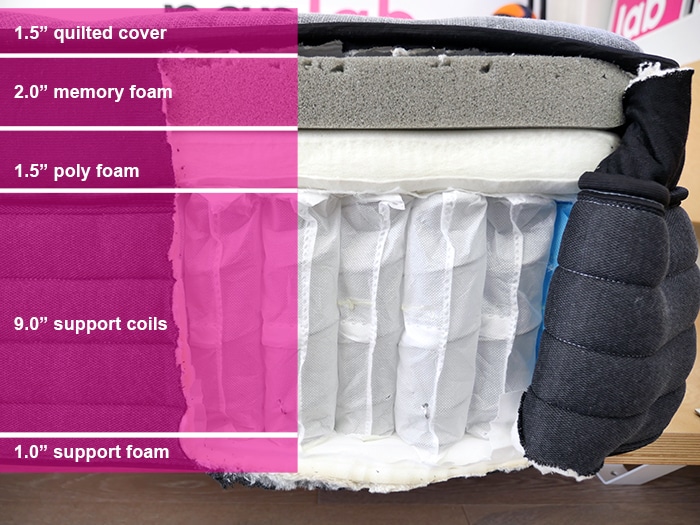
The Cover
The cover of the Zoma Boost is a thin, cooling cover. It is tufted and has a dark gray aesthetic.

The Comfort Layer
Below the quilted cover is the memory foam comfort layer. This layer uses a 2″ thick graphite-infused memory foam to wick away heat. Much like gel or copper-infused memory foam, graphite-infused foam is a way to create a foam that is cooler than traditional memory foam.

Below the graphite foam, there is a 1.5″ transitional layer of poly foam, which eases pressure into the support layer.
The Support Layer
The support layer is made of 8.0″ pocketed support coils. These coils are individually encased in a thin fabric that allows the coils to move independently of each other as well as reduce noise and motion transfer.

The base of the mattress is a 1.0″ thick high-density support foam, which helps the mattress to retain its shape.
Product Evolution
The Zoma Boost is the newest mattress in the Zoma collection, which launched in February 2023.
It provides a higher-end mattress with a thicker profile and better performance than the more budget-friendly Zoma Hybrid or Zoma Start (all foam).
Zoma Boost vs. Zoma Hybrid

Zoma Boost
| Type: Hybrid |
| Thickness: 15″ |
| Firmness: Medium Firm (6) |
| Price: $1,349 (queen) |
| Overall Score: 8.88 |
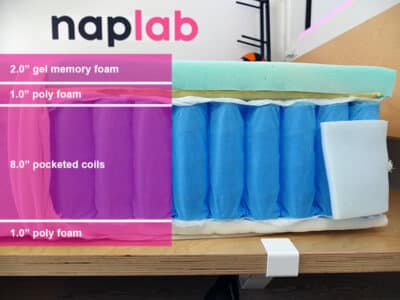
Zoma Hybrid
| Type: Hybrid |
| Thickness: 12″ |
| Firmness: Medium (5) |
| Price: $974 (queen) |
| Overall Score: 8.86 |
Other Mattresses to Consider
Not sure if the Zoma Boost is the right option for you? Check out these three other top-rated hybrids for some alternative picks.
For Performance
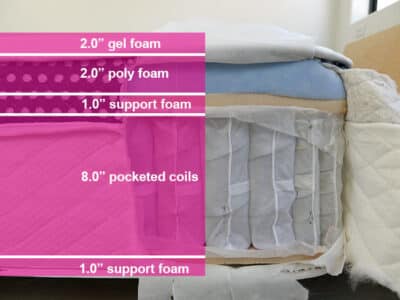
Winkbed
Available in Three Firmnesses
The Winkbed hybrid is a luxury hybrid option certainly worth considering. At 15″ tall, the Winkbed offers exceptional comfort, pressure relief, and edge support. The overall score is tied for the best we’ve tested to date (9.82 overall).
For Budget

Zoma Hybrid
Under $1000 for a Queen
The Zoma Hybrid is a nice alternative to the Boost if you’re okay with a lower profile and more bounce. This mattress uses a 2″ gel memory foam for the primary comfort layer and has a thin, breathable, non-tufted cover. It also has a slightly softer feel—5 out of 10.
For Motion Transfer
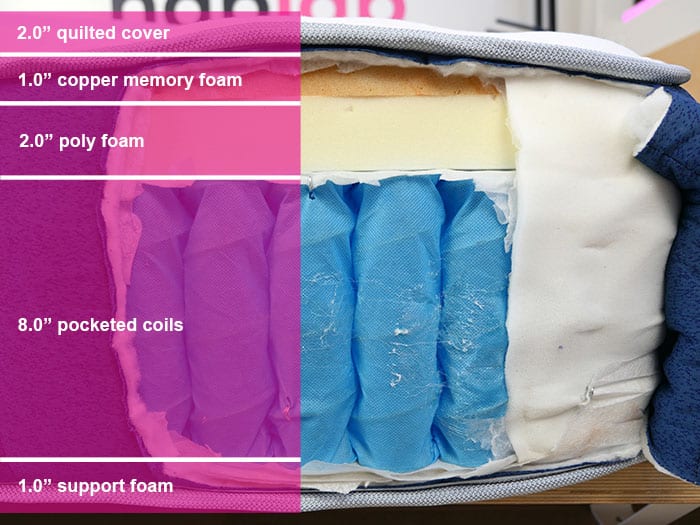
Bear Elite Hybrid
Overall Score: 9.24
The Bear Elite hybrid is a 14″ high-profile hybrid and has about 60% lower motion transfer (3.74 m/s²) than the Zoma Boost (10.90 m/s²). This mattress is also available in three different firmnesses and is at a slightly less expensive price point as well.
Frequently Asked Questions
Still have questions? Check out some of the top FAQs on the Zoma Boost mattress below and get the answers you’re looking for.
Here are the current prices, with any sales or promotions reflected below:
Twin: $1,011
Twin XL: $1,086
Full: $1,161
Queen: $1,349
King: $1,574
Cal. King: $1,574
Split King: $2,173
*Note: Sales prices are subject to change without notice or warning.
The Zoma Boost (and all other Zoma mattresses as well) is made in the United States.
Zoma offers an all-foam mattress, the Zoma Start, as well as two hybrid options, the Zoma Hybrid or the Zoma Boost (a more luxury hybrid).



